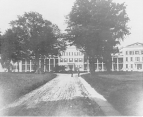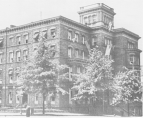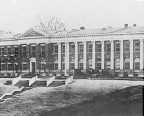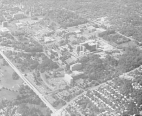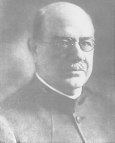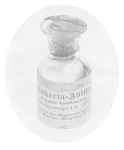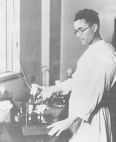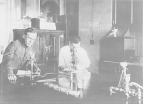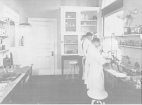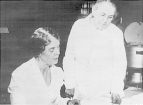 Biomedical Research
Biomedical Research
The Beginnings of Organized Biomedical Research
The discovery of the microbes causing infections diseases such as tuberculosis, cholera, diphtheria, and typhoid fever during the 1880s and 1890s created a revolution in medical thought and practice. The Hygienic Laboratory was established at the Marine Hospital on Staten Island, New York in 1887 to apply the methods of this new science of bacteriology to the diagnosis and study of epidemic diseases. The establishment of this single room bacteriological laboratory by the U.S. Marine Hospital Service marked the beginning of the National Institutes of Health and laid the groundwork for government-supported scientific research in the United States.
The Marine Hospital Service was responsible for diagnosing infectious diseases among passengers on incoming ships to prevent the entry of disease into the United States. Under the leadership of its first Director, Joseph J. Kinyoun, an early American proponent of the germ theory of disease, and equipped with the best German instruments, the Laboratory began doing some very fine work in the diagnosis, study, and treatment of cholera, yellow fever, smallpox, and bubonic plague. Of special concern were cholera and yellow fever, the two great scourges of 19th century America.
Many studies and experiments were made on different kinds of disinfectants. Special fumigation apparatus was designed. Water was tested for the presence of disease-causing microbes.
In 1891 the Hygienic Laboratory moved from Staten Island to larger quarters in Washington. D.C., where its sections were expanded to include pathology, chemistry, pharmacology, and zoology. The workload and the responsibilities increased even more significantly after the passage of the Biologics Control Act in 1902. The task of testing as well as regulating the production of all vaccines and other biologic products was delegated to the Laboratory.
The Ransdell Act in 1930 officially changed the name of the Hygienic Laboratory to the National Institute of Health, and the move to its present site in Bethesda, Maryland began in 1938. Thus from the single room bacteriological laboratory in Staten Island's hospital for sick and disabled sailors grew one of the largest biomedical research organizations in the world.
Gallery
The National Institutes of Health began as a single room Laboratory of Hygiene for bacteriological investigation established by the U.S. Marine Hospital Service at Stapleton, Staten Island, New York, in 1887. From 1887 to 1891 the Laboratory was located in the attic of the Marine Hospital on Staten Island, which had been the Seaman's Retreat until leased by the Federal Government in 1883 and made part of the Marine Hospital Service. The building that housed the Laboratory still stands and is part of the Bayley Seton Hospital.
c. 1887
In 1891, after four years on Staten Island, the Hygienic Laboratory, as it began to be called, moved to Washington, D.C., where it occupied the top floor of the Butler Building on Capitol Hill; the building was the headquarters of the Marine Hospital Service. The Laboratory was housed there for fourteen years until a separate building for it was completed. The Laboratory needed more space for its new functions of giving courses in bacteriology and pathology to Service officers, and regulating the sale of biologic products. Space was needed also for the newly created divisions of chemistry, zoology, and pharmacology and the existing division of bacteriology and pathology.
c. 1900
In 1901 Congress appropriated funds for a new building for the Hygienic Laboratory and provided a five-acre site on the old Naval Observatory grounds at 25th and E Streets, N.W. The building was completed in 1904 but soon proved too small for the quickly expanding laboratory. By the time the research laboratories began the move to their present site in Bethesda, Maryland, in 1938, a south wing and two additional buildings had been added.
c. 1910
The National Institutes of Health campus covers 306 acres in Bethesda, Maryland. In 1930 the Ransdell Act changed the name of the Hygienic Laboratory to the National Institute of Health. With the creation of other research units, the name was changed again in 1948 to the National Institutes of Health. The move to this present location began in 1938.
c. 1986
Bacteriologist Joseph J. Kinyoun (1860-1919), a graduate of Bellevue Hospital Medical College in New York City, was the first director of the Hygienic Laboratory from 1887 to 1899. He helped design the Kinyoun-Francis sterilizer, a portable steam disinfecting apparatus used in the quarantine service, and was instrumental in introducing the production of diphtheria and tetanus antitoxin serums in the United States.
c. 1895
The 1902 Biologics Control Act authorized the Hygienic Laboratory to inspect firms producing vaccines, and grant licenses to those that met rigorous standards of cleanliness and product purity. The technique to produce diphtheria antitoxin was first announced in Europe in the fall of 1894. This bottle of diphtheria antitoxin, produced by the Hygienic Laboratory and dated May 8, 1895, is the oldest known sample in the United States. It is being preserved at the Smithsonian Institution's National Museum of American History.
1895
Testing vaccines and serums for purity and potency. The National Institutes of Health played a leading role in the development and regulation of biologic products that have protected the lives of millions of Americans from 1903, when the 1902 Biologics Control Act became effective, until the transfer of these regulatory functions to the Food and Drug Administration in 1972.
c. 1930
Most of the bacteriology work and all of the biologics control from 1903 to 1937 was done in the Hygienic Laboratory's Division of Pathology and Bacteriology. This division made major contributions to the study of over 30 infectious diseases.
1925
Researchers at work on biologics control. In 1937 this work was placed in a newly established Division of Biologics Control. In 1944 this division was redesignated the Laboratory of Biologics Control.
c. 1930
Researcher Emily Emmart working in the NIH's Rocky Mountain Laboratory in Hamilton, Montana. The laboratory had been established by the state for the study of Rocky Mountain spotted fever, and became a part of the Public Health Service as a result of legislation enacted in 1931.
c. 1937
Bacteriologists Ida A. Bengston (1881-1952), on the left, and Alice C. Evans (1881-1975) were the first women employed on the scientific staff of the Hygienic Laboratory. Ida Bengston was particularly noted for her studies of bacterial toxins, especially the discovery of the organism Clostridium botulinum, which caused limberneck, a paralytic disease in chickens. Alice Evans identified undulant fever as a human form of abortive fever in cattle and traced its transmission to contaminated milk. This hastened the spread of the pasteurization movement in the United States.
c. 1940



